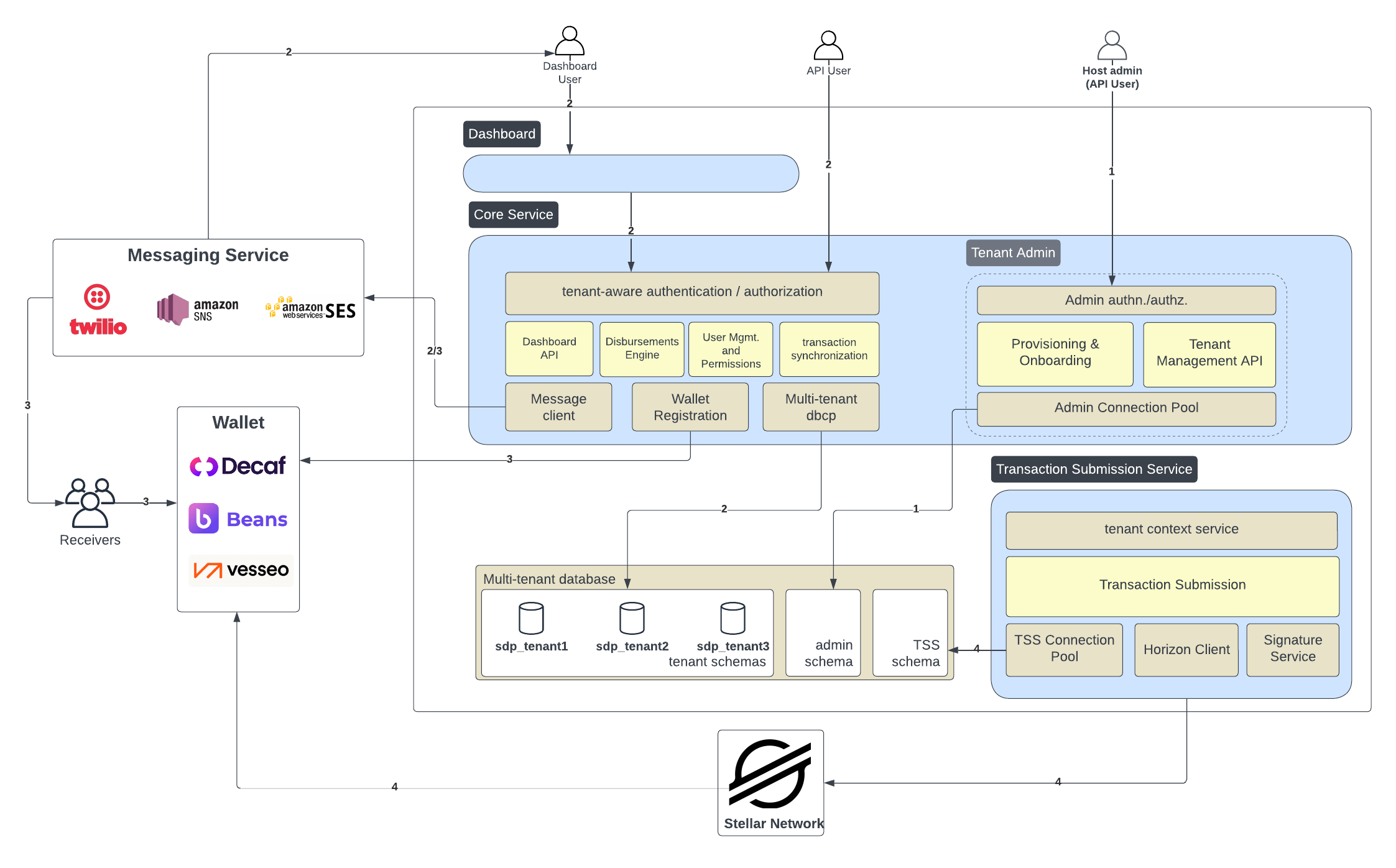Architecture
The Stellar Disbursement Platform consists of three services deployed together:
- Dashboard: the user interface administrators use to initiate and track the progress of disbursements
- SDP Core Service: the core backend service that performs several functions:
- Dashboard API: the API used by the front-end UI for all disbursement requests. The API is documented here
- Admin API: the API used by the host organization to manage tenant provisioning and configuration. The API is documented here
- Messaging Service: a recurring process that sends text messages to users prompting them to download the wallet selected for a particular disbursement and verify their phone with an OTP
- Wallet Registration: a web application registers a recipient by collecting and verifying their OTP code and verification information via Stellar’s SEP-24: Hosted Deposit and Withdrawal protocol
- Transaction Submission Service: the service that submits all payment transactions to the Stellar network. This service is designed to maximize payment throughput, handle queuing, and graceful resubmission/error handling
Dependencies
- Container Orchestration: the SDP is packaged as Docker containers and can be deployed to Kubernetes or AWS Fargate. SDF provides a Helm Chart for Kubernetes
- Postgres: the SDP uses a Postgres database server for all of its services
- Twilio or AWS SNS and SES: the SDP’s messaging service uses SMS/WhatsApp messages via Twilio or AWS SNS and administrative emails for organization account setup and recovery via AWS SES or Twilio SendGrid
- Stellar Accounts:
- Distribution Account: the SDP requires access to at least one funded Stellar account to make payments to the recipient
- SEP-10 Auth Account: the SDP requires a Stellar account for the mutual authentication protocol SEP-10: Stellar Web Authentication used to connect to wallet applications
Architecture Diagram

User Roles
The SDP defines the following user roles:
- Host Admin: the organization that hosts the SDP instance and manages tenant provisioning and configuration via the
Tenant AdminAPI - Dashboard User: a user that belongs to a tenant and uses the SDP Dashboard to create and manage disbursements, recipients, and other tenant-specific data.
- API User: a user that belongs to a tenant and uses the
Dashboard APIto create and manage disbursements, recipients, and other tenant-specific data programmatically - Receivers: the end users that receive the funds sent via the SDP. Receivers can either use a wallet application that supports SEP-24 for automatic registration, or they can receive funds directly to their Stellar account.
Workflow
- Host admin uses the
Tenant AdminAPI to provision and manage tenants. Dashboard UserandAPI Useruse the SDP Core Service to send disbursements and manage / invite other users. This can be done via the Dashboard UI or directly via theDashboard API.- For payments that require SEP-24 registration, the
SDP Core Servicesends a message to notify the receivers. The message contains a deeplink that launches the target wallet, which in turn triggers the SEP-24 deposit flow and registers the receivers. - The TSS pulls payments that ready to be processed then submits them to the Stellar Network through Channel Accounts.
Database & Schemas
The SDP uses a Postgres database for all of its services. The database schema is managed by the SDP Core Service and is versioned in the codebase. The database schema is designed to be tenant-aware, meaning that each tenant has its own set of tables and data. This allows the SDP to be multi-tenant and support multiple organizations using the same instance.
There are 3 types of schemas in the database:
- Admin Schema: contains tables for managing tenants. This schema is used by the Admin API to manage tenant configuration and provisioning.
- TSS Schema: contains tables for managing transactions. This schema is used by the Transaction Submission Service to manage the state of payment transactions.
- Tenant Schemas: each tenant has its own schema that contains tables for managing disbursements, recipients, and other tenant-specific data. These schemas are prefixed with
sdp_.
Multi-tenancy
The SDP can be deployed in a multi-tenant configuration, where multiple organizations share the same instance of the SDP. Each organization is referred to as a tenant and has its own set of data and configuration. A host organization can manage multiple tenants and manage their configuration through the Admin API.
Tenant Resolution
The SDP uses a tenant resolution strategy to determine which tenant a request belongs to. Tenant resolution is only required for unauthenticated requests, as authenticated requests include the tenant information already in the JWT token.
- Header: the
SDP-Tenant-Nameheader is used to specify the tenant name in the request. When present, this header is used to attempt resolving the tenant. - Subdomain: the SDP can use the subdomain of the request URL to resolve the tenant. For example,
tenant1.sdp.backend.testwould resolve to the tenanttenant1.
Resolution priority goes as follows: JWT token (authenticated requests) > Header > Subdomain.
Single Tenant Mode
When single tenant mode is enabled using the SINGLE_TENANT_MODE environment variable, all tenants will automatically resolve to the default tenant. A default tenant is set by calling the API POST /tenants/default-tenant.
Default tenant is useful for development purposes or when the SDP is used by a single organization. This allows the organization to skip specifying the tenant in every request and simplifies the SDP setup operationally by removing the need of providing wildcard TLS certificates for multi-tenant configurations.
Subdomain Resolution
When running the SDP in multi-tenant mode, the SDP uses the subdomain of the request URL to resolve the tenant. For example, tenant1.sdp.backend.test would resolve to the tenant tenant1. This allows the SDP to differentiate between tenants without requiring the tenant name to be specified in the request.
The subdomain resolution is particularly important for the Wallet Registration process, as the SDP relies on subdomains to differentiate between tenants during the SEP-24 deposit flow. Home domains, which contain the tenant name as a subdomain, are used during the registration process by the SDP to identify the tenant and route the wallet-registration request to the correct tenant context.